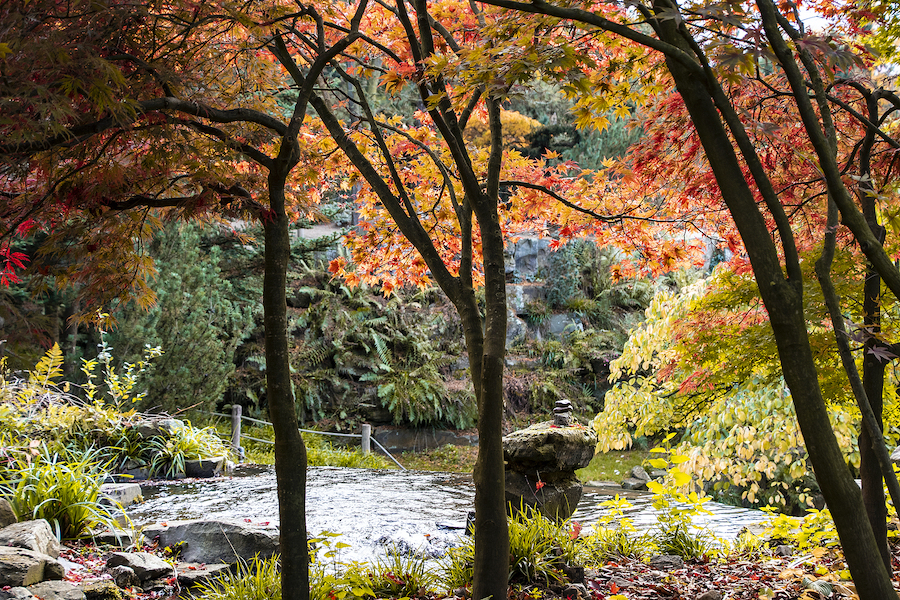
When you go outside this month to decorate your porch or rake your leaves you may start to notice plants struggling that were looking healthy during the summer. This can confuse and bewilder homeowners. A once healthy fir tree may start dropping its needles, or a mature ornamental tree will drop its leaves a month early. Although it’s been weeks since the summer heat wave, these are symptoms your landscape was under summer water stress.
What’s normal and what is a sign for concern? This can be hard to determine but here are some troubleshooting tips to help you prevent and diagnose drought stress in your landscape:
Needle drop on your conifers
You have established conifers that are losing their needles like crazy. This can be dramatic, but it is usually a normal part of getting ready for winter for most conifers. If the interior needles (closest to the trunk) of your trees are shedding that is probably normal.
Signs to watch out for: The center branch (central leader) having dieback issues. This is a sign the tree could not get water into its system. The tips or new growth drying out and losing needles or entire branches. A tree care professional can determine if selective pruning will help your plant recover or not.
Leaf drop or branch die off in ornamentals
Die out in the crown or on main branches of trees or early leaf drop can be dramatic and very concerning to homeowners. Many deciduous ornamental and flowering trees will drop leaves in order to combat drought stress. On young plants you can slightly scrape the bark and if you reveal green it’s likely going to be ok. Maintenance involves diagnosing issues, removing any dead wood and in many cases this will restore the plant’s health.
Early fall color on ornamental shade trees or shrubs
Although beautiful, this can be alarming! Check to see if leaf buds are still developing normally in the dormant period. These can usually be found at the base of the dropping leaf. Be mindful to offer irrigation during dry autumn times, or dry spells prior to a frost.
Perennials browning or crisping, dropping flowers early
It is not uncommon for perennials to be looking rough by the fall. If you have flowers and ornamental grasses in your landscape that have well established root systems, this is probably not cause for alarm. You can wait for the foliage to begin to die back naturally and then help by cutting back remaining foliage. Landscape technicians will mulch leaving some space for the crown of perennial plants to emerge the next spring.
Plants need a lot less water by the time September comes around, but once the ground is freezing, plants cannot take up moisture, even if the surrounding soil is moist. So water your plants and trees that are in containers and the landscape prior to a freeze.
Disease and Pests
Pathogens and insects often attack plants when they are undergoing stress. Ongoing landscape maintenance is the key to monitoring and keeping your garden healthy to prevent diseases and infestations before they start. If you do have an issue that requires treatment, increasing the overall health of your soil and plant is imperative to helping your plants recover. Multiple threats will attack stressed plants, so make sure an experienced professional diagnoses all your disease and insect issues.
Landscape techniques to prevent summer drought stress
Regular steady irrigation schedule, adjusted to the seasonal weather conditions is so important to establishing a healthy landscape.
An automatic sprinkler or drip irrigation system. These actually save you money and conserve water by getting your landscape the irrigation it needs in regular intervals.
Give your landscape trees room to mature, do not plant annuals and perennials right at the base of trees. Give a buffer of 3-5 feet around trees to ensure that you do not drown or bury the base of your tree in bark, compost or other plantings. Young trees need longer durations of deep watering than other plants, so be sure to target their needs specifically.
Monitor slopes and drainage issues. Areas of the landscape on hills or slopes often need water delivered at a slower rate. They also pose a challenge to plant your landscape plants at the proper depth.
Ongoing landscape maintenance will help prevent stress issues, but if your garden is displaying the symptoms of drought stress this fall, we can help you diagnose and salvage your landscape so that by next spring it is revitalized and healthy again.
Call us today to schedule your landscape maintenance or tree care consultation.

